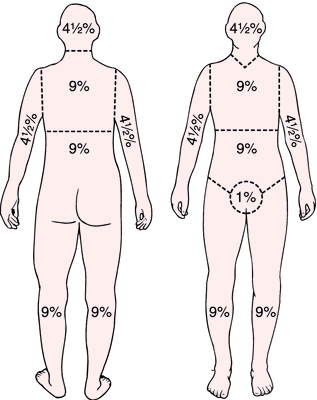rule
[ro̳l]
rule
(rūl),See also: law, principle, theorem.
rule
Vox populi A statement of the parameters usually associated with a particular condition or state. See Birthday rule, Chambon's rule, Cram-down rule, Discovery rule, Durham rule, Eight-hr rule, Federal Rules of Evidence, Federal Rules of Civil Procedure, Federal medical privacy rule, 55 rule, FFP rule, Frye rule, Gag rule, GU-AG rule, Ingelfinger rule, Haldane's rule, Locality rule, Loser pays rule, Marquis of Queensbury rule, M'Naghten rule, N-end rule, Normal rule, Prudent person rule, Safe harbor rule, Trapezoidal rule.rule
(rūl)See also: law, principle, theorem
rule
Javal's rule A relationship that relates corneal astigmatism to the total astigmatism of the eye. It states that
Kestenbaum's rule A procedure designed to estimate the power of the addition needed to read ordinary newsprint (about Jaeger 5 or N7-8) in low vision patients. It consists of dividing the denominator of the Snellen visual acuity fraction by its numer-ator (i.e. 1/Snellen visual acuity). Example: if the Snellen visual acuity is 6/60 (20/200) the power of the add will be +10D, which corresponds to a magnification of 10/4 = 2.5✕. Syn. Kestenbaum's formula.
Knapp's rule See Knapp's law.
Kollner's rule Lesions of the outer retinal layers and changes in the ocular media produce a blue-yellow colour vision defect, whereas lesions of the inner retinal layers, the optic nerve and the visual pathway produce a red-green defect. Examples: age-related maculopathy causes a blue-yellow defect; optic neuritis causes a red-green defect. There are exceptions to this rule, particularly during the evolution of a disease. Syn. Kollner's law.
near point rule A device for measuring the near points of accommodation and convergence. The RAF rule consists of a graduated four-sided bar on which is mounted a movable target holder which can be moved in the median plane of the head. The bar is calibrated in centimetres and dioptres (Fig. R15). See push-up method.
PD rule A ruler calibrated in millimetres used for measuring the interpupillary distance. Some have the zero point in the middle and the gradations on each side to measure two half-distances thus taking into account facial asymmetry. Many PD rules also have facilities for measuring frames (Fig. R16). Syn. pupillometer (although it is an incorrect use of this term, it is frequently used as a synonym).
Prentice's rule See Prentice's law.
Prince's rule A device for determining the location of the near point of accommodation and the amplitude of accommodation. It consists of a ruler scaled in dioptres on one side and in millimetres on the other. One end of the ruler is held against the face and a test card is moved along the ruler towards the eye until a blur is noticed. The amplitude of accommodation in dioptres represents either the ocular accommodation (if the reference point is the cornea) or the spectacle accommodation (if the reference point is the spectacle plane).
| Table R3 Power of the addition required (and corresponding focal length) to read ordinary newsprint (about J5 or N8) in low vision patients, for various acuities. The add is calculated according to Kestenbaum's rule and is an estimate | ||||||||
| Acuity at 40 cm | Snellen equivalent at 40 cm | power of add (D) | focal distance of add (cm) | |||||
| (m) | (ft) | |||||||
| 40/80 | 6/12 | 20/40 | +2 | 50 | ||||
| 40/100 | 6/15 | 20/50 | +2.5 | 40 | ||||
| 40/120 | 6/18 | 20/60 | +3 | 33 | ||||
| 40/140 | 6/21 | 20/70 | +3.5 | 29 | ||||
| 40/160 | 6/24 | 20/80 | +4 | 25 | ||||
| 40/200 | 6/30 | 20/100 | +5 | 20 | ||||
| 40/250 | 6/38 | 20/125 | +6.25 | 16 | ||||
| 40/320 | 6/48 | 20/160 | +8 | 12.5 | ||||
| 40/400 | 6/60 | 20/200 | +10 | 10 | ||||
| 40/500 | 6/75 | 20/250 | +12.5 | 8 | ||||
| 40/600 | 6/90 | 20/300 | +15 | 6.7 | ||||
| 40/800 | 6/120 | 20/400 | +20 | 5 | ||||
| 40/1200 | 6/180 | 20/600 | +30 | 3.3 | ||||
| 40/1600 | 6/240 | 20/800 | +40 | 2.5 | ||||
rule
(rūl)Patient discussion about rule
Q. What she should do, if found positive? my wife who is 31 years, had breast cancer history in her family and I have advised her to have a test. She will have her test done next week. What she should do, if found positive?
Q. The HIV test came back POSITIVE! My very close friend 'Demonte'. One day in December as he was returning from a business trip, his wife met him at the airport with terrible news. During a routine pregnancy check up, her doctor had administered an HIV test along with other blood-work. The HIV test came back POSITIVE! The doctor wanted to begin administering drugs immediately but the cost of these drugs here when compared to their family income was prohibitive. I helped him with some of my savings. He already sold his favorite sentimental car to save his precious wife. Now i want to know is there any NATURAL medicine to cure this? Hope it costs less and available.
Q. is her2 positive more agressive than her2 negative? i know someone with her2 positive breast cancer and her doctor said it was more difficult to detect upon its return if it came back i want to know if it is true and what can she do to detect it earlier

